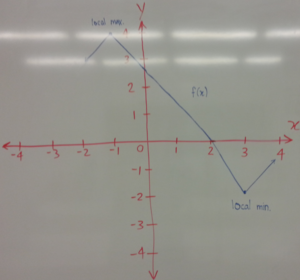Science:Math Exam Resources/Courses/MATH104/December 2013/Question 01 (j)
{{#incat:MER QGQ flag|{{#incat:MER QGH flag|{{#incat:MER QGS flag|}}}}}}
• Q1 (a) • Q1 (b) • Q1 (c) • Q1 (d) • Q1 (e) • Q1 (f) • Q1 (g) • Q1 (h) • Q1 (i) • Q1 (j) • Q1 (k) • Q1 (l) • Q1 (m) • Q1 (n) • Q2 (a) • Q2 (b) • Q2 (c) • Q2 (d) • Q2 (e) • Q2 (f) • Q2 (g) • Q3 • Q4 • Q5 • Q6 (a) • Q6 (b) • Q6 (c) •
Question 01 (j) |
|---|
|
If a function is continuous for all and if has a local maximum at (-1, 4) and a local minimum at (3, -2), which of the following statements must be true? (A) The graph of has an inflection point somewhere between and (B) (C) The graph of has a horizontal asymptote. (D) The graph of has a horizontal tangent line at (E) The graph of intersects both axes. |
|
Make sure you understand the problem fully: What is the question asking you to do? Are there specific conditions or constraints that you should take note of? How will you know if your answer is correct from your work only? Can you rephrase the question in your own words in a way that makes sense to you? |
|
If you are stuck, check the hint below. Consider it for a while. Does it give you a new idea on how to approach the problem? If so, try it! |
Hint |
|---|
|
Draw a picture with the two dots in it. Try to connect the dots. Which of the given condition appears to always be true? Can you justify it? Alternatively, can you create a picture where the other four conditions are false? |
|
Checking a solution serves two purposes: helping you if, after having used the hint, you still are stuck on the problem; or if you have solved the problem and would like to check your work.
|
Solution |
|---|
|
The correct answer is (E). To show that E is correct, we can use the intermediate value theorem twice. In order for f to be a continuous function that connects and , we know that it must have some value at by the fact that the function is continuous for all real values of x. Thus, it crosses the y axis. As these two points live both above and below the x axis, we see that and since f is continuous, the intermediate value theorem states that there is some value c in the interval such that . Thus the answer is (E). Note. For the curious minded, the graph below gives a counter example to all of the other 4 conditions. |
{{#incat:MER CT flag||
}}












